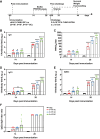A single dose recombinant AAV based CHIKV vaccine elicits robust and durable protective antibody responses in mice
- PMID: 39495779
- PMCID: PMC11563480
- DOI: 10.1371/journal.pntd.0012604
A single dose recombinant AAV based CHIKV vaccine elicits robust and durable protective antibody responses in mice
Abstract
Background: Chikungunya virus (CHIKV) is a mosquito-borne alphavirus that is responsible for Chikungunya fever, which is characterized by fever, rash, and debilitating polyarthralgia. Since its re-emergence in 2004, CHIKV has continued to spread to new regions and become a severe health threat to global public. Development of safe and single dose vaccines that provide durable protection is desirable to control the spread of virus. The recombinant adeno-associated virus (rAAV) vectors represent promising vaccine platform to provide prolonged protection with a single-dose immunization. In this study, we developed a rAAV capsid serotype 1 vector based CHIKV vaccine and evaluated its protection effect against CHIKV challenge.
Methodology: The recombinant AAV1 encoding the full-length structural proteins of CHIKV (named as rAAV1-CHIKV-SP) was generated in vitro by transfecting the plasmids of AAV helper-free system into HEK-293T cells. The safety and immunogenicity of rAAV1-CHIKV-SP were tested in 4-week-old C57BL/6 mice. The antibody responses of the mice receiving prime-boost or single-dose immunization of the vaccine were determined by ELISA and plaque reduction neutralizing test. The immunized mice were challenged with CHIKV to evaluate the protection effect of the vaccine.
Conclusions: The rAAV1-CHIKV-SP showed remarkable safety and immunogenicity in C57BL/6 mice. A single dose intramuscular injection of rAAV1-CHIKV-SP elicited high level and long-lasting antibody responses, and conferred complete protection against a heterologous CHIKV strain challenge. These results suggest rAAV1-CHIKV-SP represents a promising vaccine candidate against different CHIKV clades with a simplified immunization strategy.
Copyright: © 2024 Zhu et al. This is an open access article distributed under the terms of the Creative Commons Attribution License, which permits unrestricted use, distribution, and reproduction in any medium, provided the original author and source are credited.
Conflict of interest statement
The authors have declared that no competing interests exist.
Figures






References
-
- Schneider M, Narciso-Abraham M, Hadl S, McMahon R, Toepfer S, Fuchs U, et al.. Safety and immunogenicity of a single-shot live-attenuated chikungunya vaccine: a double-blind, multicentre, randomised, placebo-controlled, phase 3 trial. Lancet. 2023;401(10394):2138–47. doi: 10.1016/S0140-6736(23)00641-4 - DOI - PMC - PubMed
MeSH terms
Substances
LinkOut - more resources
Full Text Sources
Medical
Miscellaneous

